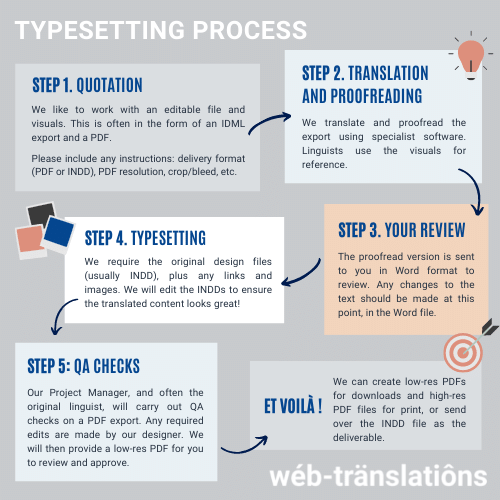Do you need to translate PDFs, brochures, or other carefully designed content? And have you considered that the layout of these translations may need to change slightly in order to accommodate longer texts, or right-to-left languages?
There’s no need to worry, as we offer a desktop publishing service that will help. Read on to find out how we can help you create perfectly localised materials for print or download.
What is Desktop Publishing?
If you haven’t heard of the term desktop publishing before, you may have heard it referred to as typesetting or DTP. This process involves using design software, such as InDesign, to create files with customisable layouts for print or download.
Simply translating an IDML file export won’t mean that your translated file is ready for printing right away. A specialist designer needs to import the translated file into InDesign, and make any changes. These changes can include:
- Lengthening text boxes
- Changing font sizes
- Tweaking elements
- Adding line breaks
- Formatting embedded graphics
The aim of this process is to make the translated file look as good as the original, whilst avoiding the ‘this has been translated’ look.
The Process

Why use Web-Translations?
Text could expand or contract by around 25% once it has been translated. This may cause some issues when trying to retain the original file’s formatting and layout. If you haven’t planned for this in advance, our designer may need to reduce a font size or increase the size of a text box, for example.
Non-Latin alphabets can also be difficult to work with for the uninitiated. One example of this is Arabic, which reads from right to left. This means that the entire page layout needs to be reversed. As most designers don’t have experience with translation and probably don’t speak the language of the target text, it can be difficult for them to rework the layout and format of the translation. In fact, some designers may even introduce errors to the translated content, as they are not translators themselves. At Web-Translations, however, we could save your designer’s both time and effort, as we have the skill to adjust the formatting and page layout of your translations ready for print.
Our experienced typesetters can tackle anything from business cards to technical manuals, and from packaging to posters, so it’s safe to say that your content is in good hands. But if you’re in the process of designing new marketing collateral for translation, check out our blog post on translating PDFs for some pointers.
Differences Between Languages
As we mentioned earlier, texts can become considerably shorter or longer during the translation process, as each language has its own structure and set of characteristics. Below we’ve provided a few examples of how much some languages can expand or contract when translating from English:
| Language | Average Expansion/ Contraction |
|---|---|
| French | 20% longer |
| German | 20% longer |
| Korean | 10% shorter |
| Swedish | 10% shorter |
| Arabic | 25% longer |
| Spanish | 20-30% longer |
| Finnish | 30% shorter |
| Norwegian | 15% shorter |
We hope these figures give you a better idea of the differences between the languages, and that you’ll be able to bear this in mind when creating your carefully designed documents.
To find out more about our language solutions, please visit our Services page. Or, if you’d like to talk to us directly, why don’t you fill in our contact form? We’re more than happy to help.
6 April 2022 11:50
